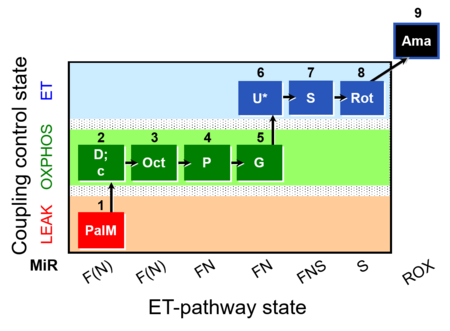| Step
|
State
|
Pathway
|
Q-junction
|
Comment - Events (E) and Marks (M)
|
| 1PalM
|
PalML(n)
|
F(N)
|
CETF
|
1PalM
- Respiratory stimulation of the FAO-pathway, F, by fatty acid FA in the presence of malate M. Malate is a type N substrate (N), required for the F-pathway. In the presence of anaplerotic pathways (e.g., mitochondrial malic enzyme, mtME) the F-pathway capacity is overestimated, if there is an added contribution of NADH-linked respiration, F(N) (see SUIT-002). The FA concentration has to be optimized to saturate the FAO-pathway, without inhibiting or uncoupling respiration.
- Non-phosphorylating resting state (LEAK state); LEAK respiration L(n) in the absence of ADP, ATP, AMP (no adenylates).
|
| 2D
|
PalMP
|
F(N)
|
CETF
|
1PalM;2D
|
| 2c
|
PalMP
|
F(N)
|
CETF
|
1PalM;2D;2c
- Addition of cytochrome c yields a test for integrity of the mtOM (cytochrome c control efficiency). Stimulation by added cytochrome c would indicate an injury of the mtOM and limitation of respiration in the preceding state without added c due to loss of cytochrome c. Typically, cytochrome c is added immediately after the earliest ADP-activation step (OXPHOS capacity P with saturating [ADP]).
- Respiratory stimulation of the FAO-pathway, F, by fatty acid FA in the presence of malate M. Malate is a type N substrate (N), required for the F-pathway. In the presence of anaplerotic pathways (e.g., mitochondrial malic enzyme, mtME) the F-pathway capacity is overestimated, if there is an added contribution of NADH-linked respiration, F(N) (see SUIT-002). The FA concentration has to be optimized to saturate the FAO-pathway, without inhibiting or uncoupling respiration.
- OXPHOS capacity P (with saturating [ADP]), active OXPHOS state.
|
| 3Oct
|
PalOctMP
|
F(N)
|
CETF
|
1PalM;2D;2c;3Oct
|
| 4P
|
PalOctPMP
|
FN
|
CETF&CI
|
1PalM;2D;2c;3Oct;4P
- Respiratory stimulation by simultaneous action of the F-pathway and N-pathway with convergent electron flow in the FN-pathway for evaluation of an additive or inhibitory effect of F.
- OXPHOS capacity P (with saturating [ADP]), active OXPHOS state.
|
| 5G
|
PalOctPGMP
|
FN
|
CETF&CI
|
1PalM;2D;2c;3Oct;4P;5G
- Respiratory stimulation by simultaneous action of the F-pathway and N-pathway with convergent electron flow in the FN-pathway for evaluation of an additive or inhibitory effect of F.
- OXPHOS capacity P (with saturating [ADP]), active OXPHOS state.
|
| 6U
|
PalOctPGME
|
FN
|
CETF&CI&II
|
1PalM;2D;2c;3Oct;4P;5G;6U
|
| 7S
|
PalOctPGMSE
|
FNS
|
CI&CII
|
1PalM;2D;2c;3Oct;4P;5G;6U;7S
- Respiratory stimulation by simultaneous action of the F-pathway, N-pathway, and S-pathway, with convergent electron flow in the FNS-pathway for reconstitution of TCA cycle function and additive or inhibitory effect of F.
- Noncoupled electron transfer state, ET state, with ET capacity E.
|
| 8Rot
|
SE
|
S
|
CII
|
1PalM;2D;2c;3Oct;4P;5G;6U;7S;8Rot
|
| 9Ama
|
ROX
|
|
|
1PalM;2D;2c;3Oct;4P;5G;6U;7S;8Rot;9Ama
- Rox is the residual oxygen consumption in the ROX state, due to oxidative side reactions, estimated after addition of antimycin A (inhibitor of CIII). Rox is subtracted from oxygen flux as a baseline for all respiratory states, to obtain mitochondrial respiration (mt).
|

